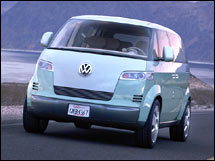NEW YORK (CNN/Money) - Volkswagen announced this summer that it will introduce a modernized version of the German carmaker's pre-minivan minivan in 2005. The original went into production in the early 1950s but really made a splash in the fab 1960s.
Modernizing is probably a good thing here. As wonderfully appealing as the old Microbus was, it had, shall we say, some issues. Even though I was, still a child when my family ditched ours, I remember the Microbus experience well. A few e-mails among my older siblings, who actually spent time in the driver's seat while I was kicking around on one of the removable bench seats in the back, filled in some of the memorable details I wasn't able to experience.
My parents bought the Microbus in 1965, about a year after I was born. Being that I was the last of my parents' 11 children, the Sunday drive to church had gotten a little snug in Mom's VW Beetle. (If my father had been the churchgoing type, they probably would have sprung for the Microbus a good bit sooner.)
 |
|
| The writer (seated in his mother's lap) with his family and their VW Microbus, Wallingford, Pa., 1966. |
I mostly remember the sound of the bus's overworked air-cooled engine and the view of tree branches whizzing by those narrow rectangular windows around the roof. Also, there was that special plastic-and-oil interior smell that VW should have trademarked in those years.
A few years after we got the bus my older brother, Mark, finally replaced the big, leaky cloth-and-vinyl sunroof with a sheet of Plexiglas and lots of caulking. All the older kids who actually drove it recall the distinctly insufficient engine, the commuter bus-style handling characteristics, and the long stick shift that was like swishing a mop around in a bucket. But, though it limped along at the end with its windshield wipers tied together and its VW nose emblem pocked with rust, it lasted us about a decade. Not a bad showing for a motor vehicle of the time.
The new version
 |
|
| VW Microbus concept |
The new Microbus, introduced as a concept vehicle in January 2001, has a few features that should make it a big improvement over the earlier versions. The concept Microbus, for example, features a 230 horsepower V6 engine and a 5-speed automatic with Tiptronic clutchless shifting.
Then there's the onboard movie multiplex theater, something I definitely would have remembered if we'd had it in ours. The concept has a 7-inch screen in the center console and four other 8-inch screens in the backs of the first and second-row seats. The middle seats can swivel for a better view of a DVD/game console screen. Folded down, the back of the DVD/game screen functions as a small table.
 |
|
| The interior of VW Microbus concept. The lever is the Tiptronic shifter. |
The seats on the concept are covered in "Cotton White" nappa leather. The second row is a pair of bucket seats that swivel 180 degrees, while the third row is a bench with two contoured seats. Both the second and third rows can be moved around on a set of rails.
The floor is covered with a semitransparent rubber mat that's easily removed so it can be hosed off. Underneath that is an aluminum floor. The combination adds a glow to the inside of the Microbus concept. Our old bus also had removable rubber flooring and, underneath that, the floor was semitransparent thanks to a material called rust.
| More on CNN/Money Autos
|

|
|
|
|
Instead of opening outward, as the doors on our old Microbus did, the concept vehicle has powered sliding doors. And the door handles retract via remote control so they stick out only when you need them.
It remains to be seen, of course, which of the fancy features from the concept vehicle will make it to the final production version. Not everything the VW design team in California came up with will likely be practical for a real production vehicle. If anyone's asking, I'd like to see the old round headlights come back. It's just not a Microbus without them. The DVD screen that doubles as a snack tray is a nice touch, though.

|

